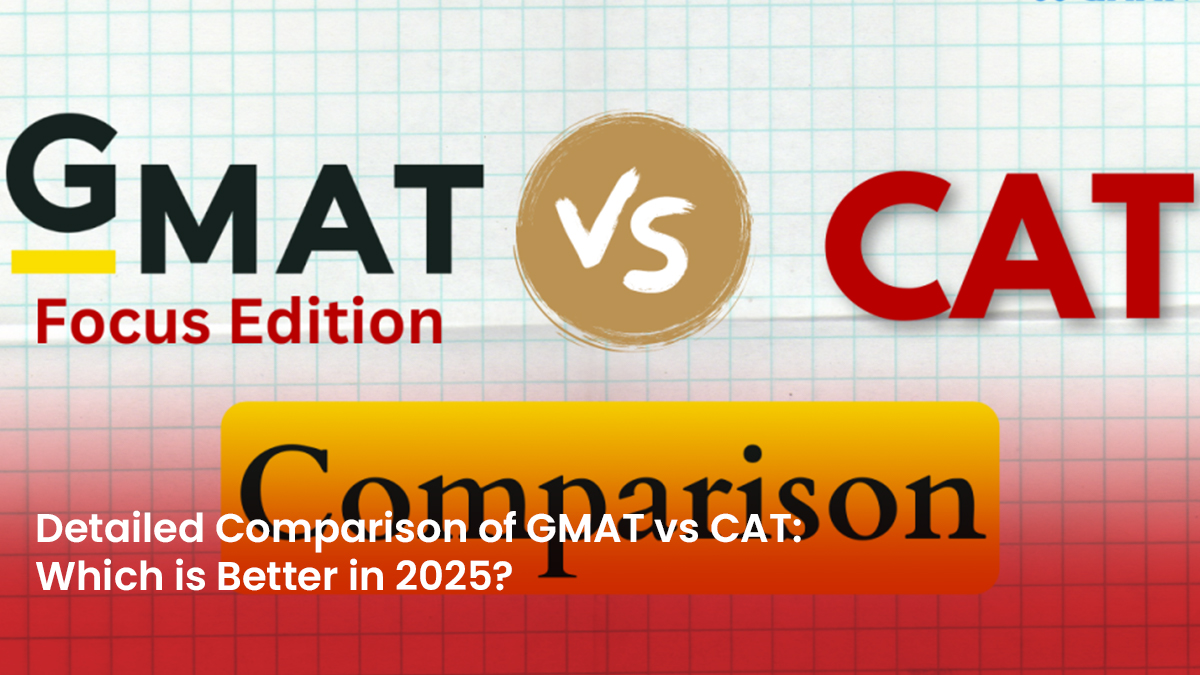Choosing between the GMAT and CAT is a critical decision for MBA aspirants, as both exams serve as gateways to prestigious business schools but cater to different audiences. The GMAT (Graduate Management Admission Test) operates under the Graduate Management Admission Council (GMAC) to assess prospective students of global MBA and graduate management curricula that lead to admission at 2,400 international business schools across 110+ nations, including Harvard, INSEAD, and select Indian institutions like ISB. The Common Admission Test (CAT), as organized by the Indian Institutes of Management (IIMs), acts as India’s top MBA entrance exam to get accepted into IIMs and more than 1300 other management institutions in the country. This article provides a comprehensive comparison of GMAT vs CAT, incorporating recent data, tables, and FAQs, to help you decide based on your academic and career goals.
Overview of GMAT
The GMAT assesses analytical, quantitative, verbal, and data interpretation skills, making it a versatile choice for international and select Indian B-schools. The GMAT Focus Edition, effective since February 2024, is the current format, with recent updates for 2025 including year-round availability and online testing options.
- Exam Structure: Three sections – Verbal Reasoning (23 questions), Quantitative Reasoning (21 questions), and Data Insights (20 questions) – with a total of 64 questions.
- Duration: 2 hours and 15 minutes, including an optional 10-minute break.
- Scoring: Scores range from 205 to 805, with no negative marking, and are valid for 5 years. Recent statistics show an average score of 658 for U.S. business schools in 2023, up from 613 five years ago.
Overview of CAT
The CAT is tailored to India’s management education landscape, testing verbal ability, data interpretation, logical reasoning, and quantitative skills. For 2024, it had 68 questions with total marks of 204, and the 2025 exam is scheduled for November 30, with registration starting in August.
- Exam Structure: Three sections – Verbal Ability and Reading Comprehension (VARC, 24 questions), Data Interpretation and Logical Reasoning (DILR, 20 questions), and Quantitative Ability (QA, 22 questions) – with a total of 66 questions for 2025, expected to follow the 2024 pattern.
- Duration: 2 hours, with 40 minutes per section, non-adaptive.
- Scoring: Each correct answer carries 3 marks, with -1 for incorrect MCQs, and scores are reported as percentiles, valid for 1 year. In 2022, 2.22 lakh candidates appeared out of 2.56 lakh registrations.
- Recent Trends: Competition is intense, with only a small percentage securing admission to top IIMs, and 14 candidates scored 100 percentile in 2024.
Key Differences Between GMAT and CAT
The GMAT vs CAT comparison reveals several key differences that can influence your choice, as summarized below:
Table 1: Key Differences Between GMAT and CAT
| Aspect | GMAT | CAT |
| Conducting Body | GMAC | IIMs |
| Purpose | Global MBA admissions | Indian B-schools admission |
| Frequency | Year-round, up to 5 attempts/year | Once a year |
| Mode | Computer-based, adaptive, online option | Computer-based, non-adaptive |
| Sections | Verbal, Quantitative, Data Insights | VARC, DILR, QA |
| Total Questions | 64 | 68 (2024) |
| Duration | 2h 15m | 2h |
| Scoring | 205-805, no negative marking | Percentile, negative marking |
| Exam Fee | ~USD 250-300 | ~INR 2,400 |
| Acceptance | 2,400+ global B-schools | ~1,300 Indian B-schools |
In the CAT exam vs GMAT debate, eligibility is similar, requiring a bachelor’s degree, but CAT has a minimum percentage (50% for general, 45% for reserved), while GMAT does not. Frequency is a major difference, with GMAT offering flexibility and CAT being annual, impacting preparation strategies.
GMAT vs CAT Difficulty: Which is Tougher?
The GMAT vs CAT difficulty question is debated, with both exams challenging in unique ways. Research suggests CAT is often seen as tougher due to its unpredictable syllabus and high competition, with over 2.49 lakh candidates in 2024. The CAT vs GMAT difficulty level is influenced by CAT’s broad syllabus, including geometry and modern math, not tested in GMAT, and its time pressure with fixed 40-minute sections. GMAT’s adaptive format adjusts difficulty, but its verbal section, particularly Reading Comprehension and Sentence Correction, can be tough for non-native English speakers. The evidence leans toward CAT being tougher for Indian test-takers due to national competition, while GMAT poses challenges for global aspirants, especially in verbal skills.
GMAT vs CAT Syllabus: What’s Covered?
The GMAT vs CAT syllabus and CAT vs GMAT syllabus differ significantly, impacting preparation. GMAT’s syllabus is well-defined, focusing on Verbal Reasoning (Reading Comprehension, Critical Reasoning, Sentence Correction), Quantitative Reasoning (Arithmetic, Algebra, Word Problems, no geometry), and Data Insights (Table Analysis, Graph Interpretation, Multi-Source Reasoning). CAT’s syllabus is broader, covering VARC (Reading Comprehension, Para Jumbles, Grammar), DILR (Data Interpretation, Logical Reasoning), and QA (Arithmetic, Algebra, Geometry, Modern Math), making it less predictable. This difference affects CAT vs GMAT preparation, with CAT requiring more extensive study due to its range.
GMAT Score vs CAT Percentile: Understanding the Scoring
The GMAT score vs CAT percentile comparison highlights distinct systems. GMAT scores range from 205 to 805, with no negative marking, and percentiles show global standing, valid for 5 years. CAT uses percentiles, with total marks of 198 (2024), negative marking for incorrect MCQs, and validity for 1 year. A GMAT score of 700+ places you in the top 20%, while a CAT’s 99+ percentile is needed for top IIMs, making direct comparison complex.
How to Choose Between GMAT and CAT
Deciding between GMAT vs CAT how to choose depends on your goals. For global B-schools, GMAT is preferable; for IIMs, CAT is essential. Career goals matter: GMAT for international roles, CAT for India-focused careers. Preparation time is key, with GMAT needing 3–6 months, and CAT often 1+ years. Strengths in English favor GMAT, while math skills suit CAT. Some take both, but it’s resource-intensive. The question of GMAT vs CAT, which is better, has no universal answer, depending on individual needs.
Conclusion
The GMAT vs CAT comparison reveals two rigorous exams with distinct purposes. GMAT offers global opportunities, while CAT is India-focused. By weighing factors like GMAT vs CAT difficulty, syllabus, and preparation, you can choose the exam that best fits your aspirations. Both require dedication, but with the right strategy, you’ll be on your way to your dream MBA program.
FAQs
- What is the main difference between GMAT and CAT?
GMAT is for global MBA admissions, while CAT is for Indian B-schools. - Which is tougher, GMAT or CAT?
CAT is often tougher due to competition, but GMAT’s verbal section challenges non-natives. - Can I use GMAT for Indian B-schools?
Yes, some like ISB accept GMAT, but IIMs require CAT. - How do GMAT and CAT syllabi differ?
GMAT focuses on verbal, quantitative, and data insights; CAT covers broader topics like geometry. - What are the costs for GMAT and CAT?
GMAT: ~USD 250-300; CAT: ~INR 2,400. - How many attempts for GMAT and CAT?
GMAT: 5 per year; CAT: 1 per year. - How does CAT compare to the GRE and GMAT?
GRE is another option, but GMAT and CAT are primary for MBA admissions in their domains.



























